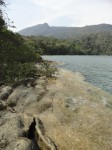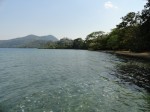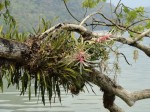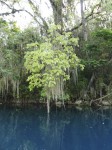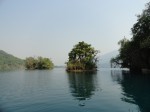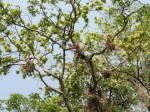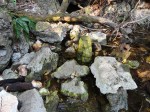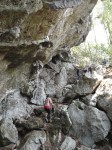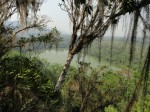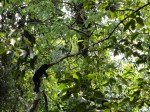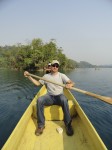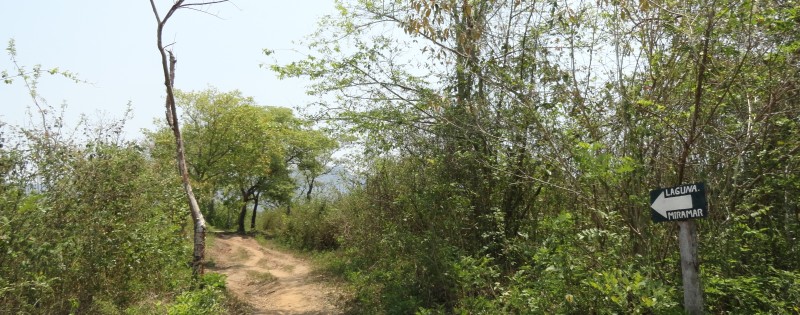
Laguna Miramar, Chiapas, México
August 10, 2014|Posted in: Ecoturismo, Nature
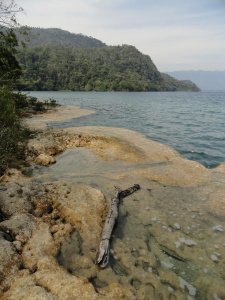 If you had told me there was a heaven and asked me what it included, I would have told you that it came with an ocean, with nice waves near the shore to body surf in and a soft beach where the sand didn’t burn your feet. After spending time in the water at Laguna Miramar, I think I’ve changed my mind. I now believe it probably would include something along the lines of this lake in the western part of Chiapas, Mexico. After we visited here for two days in April of 2014, I’m hard-pressed to remember the last time I enjoyed being in the water this much.
If you had told me there was a heaven and asked me what it included, I would have told you that it came with an ocean, with nice waves near the shore to body surf in and a soft beach where the sand didn’t burn your feet. After spending time in the water at Laguna Miramar, I think I’ve changed my mind. I now believe it probably would include something along the lines of this lake in the western part of Chiapas, Mexico. After we visited here for two days in April of 2014, I’m hard-pressed to remember the last time I enjoyed being in the water this much.
The shore of the lake is sand-like sediment in some places, hard, porous, water-smoothed rock in others, and is lapped by small waves created by wind, we think. At the time of our visit, the water just off the shore was surprisingly warm while we found the small pools in the rock beds almost at jacuzzi temperatures, no exaggeration.
Getting there is a bit of a haul. You can drive yourself or be driven by collectivo into Emiliano Zapata, the closest town, by one of two routes that run either through Tepenyac from Las Margaritas or Comitán de Domínguez or through a host of small ejidos, or villages, from Ocosingo. Either way takes hours, and the roads soon turn to dirt heading there. The route through Tepenyac is more dangerous and after completing it in a small VW hatchback rental car, we would never do it again nor would we recommend doing it yourself. You have to summit several times and the road is heavily rutted, littered with loose rock, and the inclines are often uncomfortably steep for the condition of the road itself, plus on this narrow path you have to contend with dump trucks that use the road to haul people and supplies into and out of the area. If you must go by that route, go by collectivo. It was bad enough that when it was time for us to leave Laguna Miramar, we went by the Ocosingo route rather than attempt the Las Margaritas route again. By our crude measurements, it is perhaps 150km to Laguna Miramar from Comitán de Domínguez, about half of which (the latter half) is the horrible primitive road we have just mentioned. Even the paved road is slow going though, lots of curves and lots of topes (speed bumps) to battle.
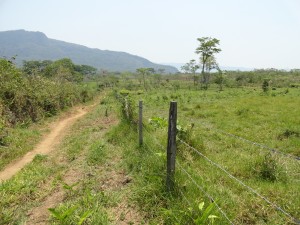 Once you’re in Emiliano Zapata, it’s a 7+ km hike from the central camp through forest, fields, and jungle to the lake itself. You can instead hire horses for yourself and/or your gear. We walked in ourselves, packs strapped to us.
Once you’re in Emiliano Zapata, it’s a 7+ km hike from the central camp through forest, fields, and jungle to the lake itself. You can instead hire horses for yourself and/or your gear. We walked in ourselves, packs strapped to us.
You can also skip the drive and take a small biplane to an airstrip that sits next to a military installation just outside of Emiliano Zapata. We don’t know much about this option, but we’ve heard the cost might be around $4k MXN but we couldn’t even say if that’s per plane or per person, and their web site doesn’t appear to mention prices. While we were told by a tour operator that the planes don’t bring in anything besides cargo, we know this isn’t true. Besides the existence of the web site advertising the tour, we saw a group of tourists that had just landed as we were leaving the area ourselves. We also know that there are helicopter tours over the lake for those who wish to get photos from above. The helicopters apparently will not bring you lakeside (for the better, in our opinion).
Before we ever arrived in Emiliano Zapata, we read in a couple of random places that we should ask after the Comité de Turismo or the Presidente de Turismo upon arriving in the ejido and we would be directed to central camp where the exchange of money for plans happens. Doing so got us to our destination, certainly, but let’s face it, rolling in as the obvious tourist that you and any of us really are, you could just as easily ask after Laguna Miramar and you would be pointed in the same correct direction. The beginning of the town is marked by a single road in and a sign notifying you that you are entering said ejido. Going straight in, then eventually taking a right, a left, another right, another left, and so on, will get you to central or base camp.
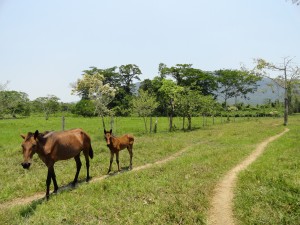 Once there, the negotiations begin, although it doesn’t feel like much of a negotiation and, in reality, there’s not much to negotiate as far as we could tell. But we reside in MX for the time being. And we speak Spanish. Well. As with every other tourist-related activity in Mexico, you’ll be asked where you’re coming from. This is on purpose. Whomever is talking to you is gauging you and your ability to spend money. Always remember prices are never fixed, but that can work both for and against you.
Once there, the negotiations begin, although it doesn’t feel like much of a negotiation and, in reality, there’s not much to negotiate as far as we could tell. But we reside in MX for the time being. And we speak Spanish. Well. As with every other tourist-related activity in Mexico, you’ll be asked where you’re coming from. This is on purpose. Whomever is talking to you is gauging you and your ability to spend money. Always remember prices are never fixed, but that can work both for and against you.
We paid $50 MXN per person per night to stay in the base camp the night we arrived, in our own tent on the land. Next to the cabañas and common area on the side of the road where the river passes, there is a slight decline to a more level area with tent spots marked out in squares with small rocks planted in the ground. This area suited us just fine and we plopped our tent here. They have six cabañas for rent if you want to spring the extra cash and those rent for $130 MXN per person. They come equipped with two double beds. We can’t speak to the quality of those but we were content in our tent for one night on the day we arrived before departing for the lake the next morning.
Aside from this charge, there’s the business of your fee for camping by the lake. Then there’s a fee for park access (you’ll be accessing a federally protected area). Then there are tours you can take, and boats, hammocks, tents, and anything else you can think of that you can rent. We can only share what we paid.
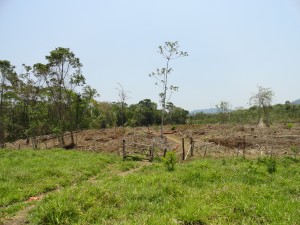 The camping fee remained the same at $50 MXN per night per person to camp lakeside with our own equipment. The access fee to stay in the protected area also came to $50 MXN per person per day (yes, per day, that means you pay every day you stay, unlike with some US national parks regarding their one-time access fees or, frankly, other protected areas in Mexico with one-time access fees as well – this might be worth arguing over).
The camping fee remained the same at $50 MXN per night per person to camp lakeside with our own equipment. The access fee to stay in the protected area also came to $50 MXN per person per day (yes, per day, that means you pay every day you stay, unlike with some US national parks regarding their one-time access fees or, frankly, other protected areas in Mexico with one-time access fees as well – this might be worth arguing over).
The tours all cost $400 MXN per tour per group. That being said, there were only two of us. Had we been a larger group, they may have attempted to charge us more, we don’t know. We were told there wasn’t much we could do at the lake (besides swimming) without taking a tour. That’s not entirely true, but we’ll get to that shortly. Anyway, we bought one tour in the end. We were presented with two options:
- One tour consisted of la cascada (the waterfall), la cueva de las tortugas (the turtle cave), and las figuras mayas (Mayan statues or figures known as “Las Manos”).
- The other tour included el mirador (a viewpoint of the lake and surrounding area), a trip out to las “Tres Islas” (the “Three Islands”), more figuras/estatuas mayas, and el Lago de Cocodrilos (the Lake of Crocodiles).
We went with the second tour. Either tour includes a guide, a large solid canoe, and some time on the lake.
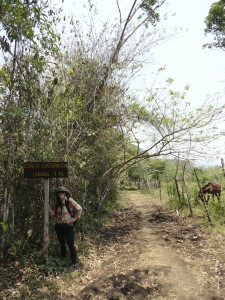 We had read that you could rent canoes for approximately $250 MXN per boat, but we found the reality to be not what we expected when speaking with the representative of the Comité de Turismo. According to him, we could rent “canoes”, certainly, but we wouldn’t be able to do nor allowed to do much with them. We were told we’d be allowed to row them about in a very limited area where we would be “watched” by the staff at the lake. I’ve rented canoes and kayaks in many different bodies of water, including open ocean. I can handle them and, typically, I’ve been allowed to take them out and explore the lake or what have you. Not what we were being told here. So we forwent the cost. And we were glad we did. When we arrived, we found that there were simple orange plastic kayaks for rent that wouldn’t get you anywhere, given the nature of the boats themselves. The real canoes and kayaks were reserved by the staff for tours and for collecting people and cargo from other parts of the lake.
We had read that you could rent canoes for approximately $250 MXN per boat, but we found the reality to be not what we expected when speaking with the representative of the Comité de Turismo. According to him, we could rent “canoes”, certainly, but we wouldn’t be able to do nor allowed to do much with them. We were told we’d be allowed to row them about in a very limited area where we would be “watched” by the staff at the lake. I’ve rented canoes and kayaks in many different bodies of water, including open ocean. I can handle them and, typically, I’ve been allowed to take them out and explore the lake or what have you. Not what we were being told here. So we forwent the cost. And we were glad we did. When we arrived, we found that there were simple orange plastic kayaks for rent that wouldn’t get you anywhere, given the nature of the boats themselves. The real canoes and kayaks were reserved by the staff for tours and for collecting people and cargo from other parts of the lake.
Having paid for everything upfront, we were presented with a receipt outlining our purchases and shown around the central camp (bathrooms with showers and running water here, common area here). We were hungry and asked after food options, of which there were none in the central camp but might be in the ejido. Our counterpart actually got on the radio with a couple of folks to see what they could cook up for us – beans, tortillas, rice maybe. However, we had meat on our minds. We thanked them and set out to explore the options ourselves, including a family that was cooking out of their home. Same story, beans, tortillas, rice, maybe eggs. There were the usual small shops selling soda, chips, junk food. In the end we walked out to Emiliano Zapata and ate at the only actual restaurant nearby that wasn’t just families cooking out of their homes. It’s located next to the airstrip and military base and caters to soldiers and passers-through like us. It turned out to be a surprisingly tasty meal when we weren’t expecting much. Again, just had a meat craving that we needed to satisfy. Walking back in the dark, we eyed the millions of stars and chatted about the next day’s details. Upon returning to central camp at the edge of the ejido, we broke out our gear and settled in for the night for a decent night of rest.
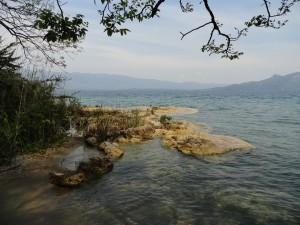 The next day we struck camp and packed up, leaving all extraneous items in the car which stayed parked in central camp. An employee led us a short trip away from central camp to the start of the trail and we then proceeded to hike to the lake at the hottest part of the day with a lot of stuff on our backs. It took us approximately 2 1/2 to 3 hours to arrive. That is not anything to benchmark against. On the way out, hiking in the cooler morning hours and having now eaten our food and consumed our water, we made it back to central camp in about 1 hour 45 minutes. In the end and unbeknownst to us, carrying drinking water beyond what we needed for the hike in itself proved to be unnecessary as there is drinking water available by the lake, piped up from underground after having fallen from the sky and been filtered by the jungle on its way into underground pools. Hence, we could have cut our packing weight and hiking time (who knows how long this source of clean water will last, but it was available when we were there, anyway). Also, the heat got to me especially. Had we gone in during a cooler part of the day, we could have cut the number of breaks we took and hence our travel time as well. What’s more, you can rent whatever you need to sleep in – a tent or even just a hammock, if you really want to go minimal. We wouldn’t recommend the tents though – a night in one is relatively expensive and the tent is of poor quality. Pack your own in, as we did, but consider bringing a lighter and smaller one than the clunker we dragged along.
The next day we struck camp and packed up, leaving all extraneous items in the car which stayed parked in central camp. An employee led us a short trip away from central camp to the start of the trail and we then proceeded to hike to the lake at the hottest part of the day with a lot of stuff on our backs. It took us approximately 2 1/2 to 3 hours to arrive. That is not anything to benchmark against. On the way out, hiking in the cooler morning hours and having now eaten our food and consumed our water, we made it back to central camp in about 1 hour 45 minutes. In the end and unbeknownst to us, carrying drinking water beyond what we needed for the hike in itself proved to be unnecessary as there is drinking water available by the lake, piped up from underground after having fallen from the sky and been filtered by the jungle on its way into underground pools. Hence, we could have cut our packing weight and hiking time (who knows how long this source of clean water will last, but it was available when we were there, anyway). Also, the heat got to me especially. Had we gone in during a cooler part of the day, we could have cut the number of breaks we took and hence our travel time as well. What’s more, you can rent whatever you need to sleep in – a tent or even just a hammock, if you really want to go minimal. We wouldn’t recommend the tents though – a night in one is relatively expensive and the tent is of poor quality. Pack your own in, as we did, but consider bringing a lighter and smaller one than the clunker we dragged along.
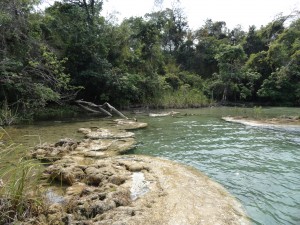 There’s not much shade to hide under for most of the hike, which consists mostly of gradual inclines and declines. You’ll find a couple of larger trees along the way under which you can find some respite from the sun. The obvious trail took us through mostly open fields of grass and by plots of corn and earth freshly scorched and being cleared of the remnants of its trees and vegetation. We encountered locals and their horses working the land and there was a constant smoke in the air in these parts of the state during our entire time in Chiapas, not just at or around Laguna Miramar. A lot of land was being cleared to make way for corn, and the smoke could be seen and smelled everywhere we turned on our inland travels. It appeared to us that bit by bit the forest is disappearing. Suffice to say that our view across the lake upon finally arriving on its shores and for the time we were there was less than crystal clear on account of this smoke everywhere.
There’s not much shade to hide under for most of the hike, which consists mostly of gradual inclines and declines. You’ll find a couple of larger trees along the way under which you can find some respite from the sun. The obvious trail took us through mostly open fields of grass and by plots of corn and earth freshly scorched and being cleared of the remnants of its trees and vegetation. We encountered locals and their horses working the land and there was a constant smoke in the air in these parts of the state during our entire time in Chiapas, not just at or around Laguna Miramar. A lot of land was being cleared to make way for corn, and the smoke could be seen and smelled everywhere we turned on our inland travels. It appeared to us that bit by bit the forest is disappearing. Suffice to say that our view across the lake upon finally arriving on its shores and for the time we were there was less than crystal clear on account of this smoke everywhere.
The protected land and forest begin at the final 1km mark on the trail. After that point, we found ourselves under cover of trees and dipping into and out of a couple of small ravines. In other words, you trade a slight increase in the difficulty of the hike for somewhat continuous shade. At this point, we were taking more frequent breaks because I was tired and overheated.
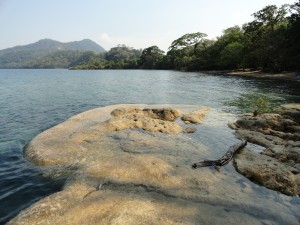 When we finally arrived we found a covered cooking area with a long elevated cooking platform on one side and a long table lining the other, as well as a covered and single-walled camping/hammock area. We threw down our stuff and were quickly greeted by one of the staff members who informed us of where the staff area was, where we could camp, and the like. We took note of the single shower area, a concrete pad with a low three-walled enclosure along a short skinny path to the two-room outhouse (which was a bit of a filthy stinky mess), and then threw on our suits and got in the water as fast as possible to cool off. Later we did some exploring of the potential camping spots and lakeshore.
When we finally arrived we found a covered cooking area with a long elevated cooking platform on one side and a long table lining the other, as well as a covered and single-walled camping/hammock area. We threw down our stuff and were quickly greeted by one of the staff members who informed us of where the staff area was, where we could camp, and the like. We took note of the single shower area, a concrete pad with a low three-walled enclosure along a short skinny path to the two-room outhouse (which was a bit of a filthy stinky mess), and then threw on our suits and got in the water as fast as possible to cool off. Later we did some exploring of the potential camping spots and lakeshore.
There were a few tourists of Mexican and other origin already enjoying the lake and occupying some of the camp spots right along the sandy part of the lakeshore. Other camp spots that had been recently utilized were littered with waste of one kind or another. Figuring that right along the shore we might be contending with more bugs and the sound of the lake’s waves while trying to sleep, and not wanting to have to clean up someone else’s mess in order to set up our tent, we settled on a less-used spot further back from the water.
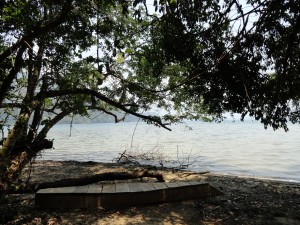 After getting situated we set about cooking up a meal. As mentioned previously, the kitchen contains a long elevated cooking platform on which two parties can cook side-by-side over fires (there are iron grill stands available that you can set over the fire you build). One Mexican family that was already there had borrowed a machete from the staff and had cut some firewood. The ground was also littered with dry kindle and wood and we found that to serve our purposes just as well. It took very little time to get a fire going and a pot set up over it with dinner. Once done with that we swam, again, and then we retired to the tent. We had been told our tour guide would come for us the next morning at 8am.
After getting situated we set about cooking up a meal. As mentioned previously, the kitchen contains a long elevated cooking platform on which two parties can cook side-by-side over fires (there are iron grill stands available that you can set over the fire you build). One Mexican family that was already there had borrowed a machete from the staff and had cut some firewood. The ground was also littered with dry kindle and wood and we found that to serve our purposes just as well. It took very little time to get a fire going and a pot set up over it with dinner. Once done with that we swam, again, and then we retired to the tent. We had been told our tour guide would come for us the next morning at 8am.
In the morning we met our tour guide, hopped in the canoe, and shoved off. The lake was very calm. We rowed out to las Tres Islas and were even invited to hop in the water for a swim while our guide waited for us, but we were good for then. The vegetation was beautiful and included wild orchids. Following this, we landed on another part of the lakeshore where we were shown a very small statue on the ground among other rocks that we were told was of Mayan origin. We then hiked to el mirador from where we had an excellent view of Laguna Miramar. On the hike up, we spied some spider monkeys moving through the trees high above and we also caught views of another neighboring lake known as el Lago de Cocodrilos. Yes, the lake contains crocodiles and is not safe for swimming nor is it recommended that you approach too closely. What that means then is that they use el Lago de Cocodrilos as one of the selling points of the tour, but you only stop on your hike up to el Mirador for a distant view of it, you never actually go lakeside. We capped off the tour by descending from el mirador, rowing a short distance to another landing point, and walking to a cliff wall in which was carved a figure of sorts. Again, we were told that carving was of Mayan origin. That concluded our tour, and we rowed back to the camping area but not before I stepped in some very, very deep mud on my way to climbing back into the boat. Sweet.
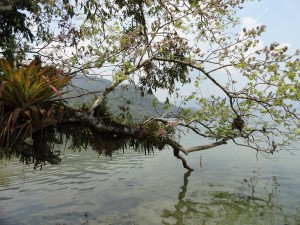 We would have been willing to take the other tour, especially since we had seen a turtle swimming in the lake as we rowed about, but the head honchos back at central camp wouldn’t agree on a price that appealed to us as we attempted to negotiate with them through our guide and the lake staff and their radio, so we thanked our guide and said goodbye and let it be. We turned our attention to the lake itself and swimming.
We would have been willing to take the other tour, especially since we had seen a turtle swimming in the lake as we rowed about, but the head honchos back at central camp wouldn’t agree on a price that appealed to us as we attempted to negotiate with them through our guide and the lake staff and their radio, so we thanked our guide and said goodbye and let it be. We turned our attention to the lake itself and swimming.
Later in the afternoon we decided to explore the area further on foot. We walked down the shoreline past the staff area and into the forest again. At a certain point we came to a fork and stayed right. Eventually we realized we had come to el Lago de Cocodrilos and, I’m not afraid to say it, we turned right the hell around and walked back the way we had come at my urging. Upon returning to the fork, we took the left tine and guess where we ended up – at the “Mayan” cliff carving that topped off our morning tour. Wouldn’t you know it. Well, they have a business to run and tours to sell and we understand that. It just rubbed us a bit the wrong way that the protocol is to discourage visitors from thinking that you can see much of anything on your own. Frankly, it’s dishonest.
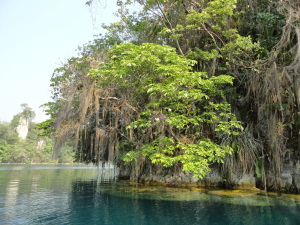 From this cliff wall the trail continues up to another mirador. We didn’t continue but instead decided to head back to camp and swim more. Upon arriving back at camp we noticed how clean the staff kept their area and how dirty the outhouse and kitchen and guest camping spots still were. Trash was quickly accumulating by the kitchen. The lake itself was still fantastic, and we enjoyed it further. And then we made veggie burritos and shared a bit of our food with the Mexican family that had borrowed the machete and had, the afternoon we arrived, shared some of their carne asada with us. And then we swam more, and I washed some of our clothing in pools of water on the porous rock shore. Again, just a perfect swimming experience all around. Amazing water, amazing temperatures, amazing surroundings, amazing rock shoreline to lounge on. We could hear howler monkeys way off in the distance on occasion. Simply surreal.
From this cliff wall the trail continues up to another mirador. We didn’t continue but instead decided to head back to camp and swim more. Upon arriving back at camp we noticed how clean the staff kept their area and how dirty the outhouse and kitchen and guest camping spots still were. Trash was quickly accumulating by the kitchen. The lake itself was still fantastic, and we enjoyed it further. And then we made veggie burritos and shared a bit of our food with the Mexican family that had borrowed the machete and had, the afternoon we arrived, shared some of their carne asada with us. And then we swam more, and I washed some of our clothing in pools of water on the porous rock shore. Again, just a perfect swimming experience all around. Amazing water, amazing temperatures, amazing surroundings, amazing rock shoreline to lounge on. We could hear howler monkeys way off in the distance on occasion. Simply surreal.
In the evening we met another couple traveling through Mexico from Europe before settling in for the night. It was hot and I was uncomfortable as hell, tossing and turning and not feeling well. At some point I fell asleep and then at some later point we awoke to the pitch black darkness exploding with light all around us. Confused and half-awake, I jumped out of the tent to collect clothes that we had put out to dry on top of the tent and on nearby tree branches. The wind was howling. Thoughts of UFO landings and getting hit by lightning simultaneously leapt through my jumbled mind. Once back inside the tent I began coming to my senses again and remembered reading about how the weather can be freakish there on the shore of the lake, how the wind coming off the lake can be severe and the storms heavy. We were in the midst of an electrical storm with no streaks of lightning and no thunder, just all-consuming flashes of white light. It took us a moment to realize that’s what was happening, but we did, and after all the excitement and the storm died down, we finally got some sleep. As another traveler had said, there’s a reason they have that covered hammock/camping area off to the side of the kitchen with a wall facing the lake, but we were safely tucked into a pocket of trees and nothing came of the storm for us.
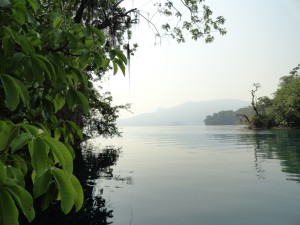 On Saturday, after having spent two nights lakeside, we looked about us and decided it was definitely time to go. The facilities were even more of a mess. Once again, the staff area was spotless, the ground nicely raked, everything in excellent shape there, but our outhouse was unusable for the condition inside and the stench, the kitchen was littered with food and trash left behind, there were piles of garbage outside the kitchen area that hadn’t been cleared for days, and visitor camp spots remained unkept. For the trash and the food and the smell, there were insects all over the place, and not just ants anymore, but a steadily increasing number of wasps over the two days we spent there. Wasps live in those forests, the forests that are being cleared for planting. And while the lake is in a protected area, the fact that the forests around it are being burned and cut out and the constant smoke in the air would seem to us to aggravate the wasps and send them to new trees, meaning the human development activities around could be causing an unintended densification of wasps in the protected land. Who knows, we’re not experts. But there’s no denying the condition of the facilities didn’t help. The wasps were aggressive and curious and bothersome. Several times we had to cease our packing activities and walk away toward the water or some other part of the area to get a brief respite from them. We would not be staying any longer to try and cook or swim or camp further, unfortunately.
On Saturday, after having spent two nights lakeside, we looked about us and decided it was definitely time to go. The facilities were even more of a mess. Once again, the staff area was spotless, the ground nicely raked, everything in excellent shape there, but our outhouse was unusable for the condition inside and the stench, the kitchen was littered with food and trash left behind, there were piles of garbage outside the kitchen area that hadn’t been cleared for days, and visitor camp spots remained unkept. For the trash and the food and the smell, there were insects all over the place, and not just ants anymore, but a steadily increasing number of wasps over the two days we spent there. Wasps live in those forests, the forests that are being cleared for planting. And while the lake is in a protected area, the fact that the forests around it are being burned and cut out and the constant smoke in the air would seem to us to aggravate the wasps and send them to new trees, meaning the human development activities around could be causing an unintended densification of wasps in the protected land. Who knows, we’re not experts. But there’s no denying the condition of the facilities didn’t help. The wasps were aggressive and curious and bothersome. Several times we had to cease our packing activities and walk away toward the water or some other part of the area to get a brief respite from them. We would not be staying any longer to try and cook or swim or camp further, unfortunately.
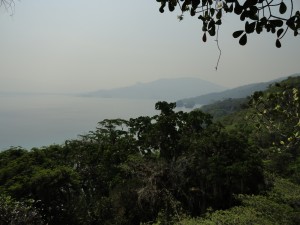 We believe in leave-no-trace camping and traveling, or better yet, leave the area in a better condition than in which you found it. But here, while the managing organization is perfectly happy to charge for everything, and to charge a fair amount, and to even misrepresent the realities by the lake to make even more money off “ecoturismo”, the staff isn’t doing much to earn that money. So while the lake itself was a dream and we would tell anyone who has the opportunity to go see it before it’s too late, before it’s changed for the worse forever, the managing organization could stand to learn a few things from the folks over at Madre Sal about how to maintain an ecoturismo site.
We believe in leave-no-trace camping and traveling, or better yet, leave the area in a better condition than in which you found it. But here, while the managing organization is perfectly happy to charge for everything, and to charge a fair amount, and to even misrepresent the realities by the lake to make even more money off “ecoturismo”, the staff isn’t doing much to earn that money. So while the lake itself was a dream and we would tell anyone who has the opportunity to go see it before it’s too late, before it’s changed for the worse forever, the managing organization could stand to learn a few things from the folks over at Madre Sal about how to maintain an ecoturismo site.
As stated above, it took us much less time to hike out, having consumed our food and most of our water and hiking out in the cooler morning hours. We hauled ass, actually. When we got back to the outskirts of the ejido, there was a small footbridge (two planks of wood set across a small ravine) left to cross before scaling the hillside back up into central camp. As I was crossing last, one of the planks gave way and collapsed on me, nearly sending me into the small ravine. Instead, I landed on my stomach, partly on the one remaining plank and partly on the dirt on the other side, one leg and hip hanging down into the ravine. Pulling myself back up and brushing myself off and cursing, we resumed the last tiny bit of our hike. All this to say pay attention to where you tread.
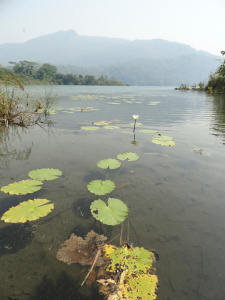 Back in central camp, we noticed that the car looked different. It hadn’t moved but someone had “washed” it. It wasn’t the best scrub job it’s had in its life I’m sure but someone had definitely taken to it with some water. As we were loading things in the car, we noticed two employees watching us under the tin roof extension of one of the cabañas. I asked them who had washed the car, and one of the gentlemen responded that he had. Well, that was done for a tip, no doubt, and not that we wanted to pay one peso more (still irritated about the condition of the facilities by the lake) but what the hell, the car had been really dirty. I thanked him, I handed him some coins, we finished packing up, and we got out of there.
Back in central camp, we noticed that the car looked different. It hadn’t moved but someone had “washed” it. It wasn’t the best scrub job it’s had in its life I’m sure but someone had definitely taken to it with some water. As we were loading things in the car, we noticed two employees watching us under the tin roof extension of one of the cabañas. I asked them who had washed the car, and one of the gentlemen responded that he had. Well, that was done for a tip, no doubt, and not that we wanted to pay one peso more (still irritated about the condition of the facilities by the lake) but what the hell, the car had been really dirty. I thanked him, I handed him some coins, we finished packing up, and we got out of there.
Again, we were not about to leave by the way we came in. We exited the ejido, drove through Emiliano Zapata, saw those tourists who had just landed by way of biplane at the airstrip, bought some soda at the restaurant we had eaten at the first night, and meandered our way out of town ultimately toward Ocosingo, which is also a through-point for the Palenque Mayan ruins further to the north. The Ocosingo route is probably around 125km from lake to paved highway where you can finally catch the Ocosingo turnoff. Most of that is dirt road but in much better condition than the other way through Tepenyac and Las Margaritas. Still, it’s slow going with plenty more topes to bounce over and ejidos to drive through. You’ll also encounter many people walking or riding bikes or horses along the road, so caution is key. The final 40km or so of this 125km is a mix of dirt and paved, back and forth as if the locals had never been able to make up their minds whether they really wanted pavement out there or not.
Once we made it to the Ocosingo highway turnoff, we pointed ourselves in the direction of Comitán de Domínguez, the magic of the lake still keeping us afloat. We could feel the movement of the water yet…
{Last Visit: April 2014}
- Orchids
- Supposed Mayan artifact
- Hiking up to el mirador
- El Lago de Cocodrilos
- Spider monkeys in the trees
- Just paddlin’, man…
Leave a Reply
You must be logged in to post a comment.
